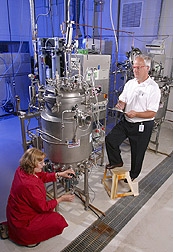This page has been archived and is being provided for reference purposes only. The page is no longer being updated, and therefore, links on the page may be invalid.
|
Read the magazine story to find out more. |
Fungus on Tap to Fight Whiteflies, Other PestsBy Jan SuszkiwAugust 5, 2003 Trouble is literally brewing for silverleaf whiteflies, thrips, spider mites and other insect plant pests. The trouble in question is a new fermentation procedure that the Agricultural Research Service has patented for mass-producing spores of the fungus Paecilomyces fumosoroseus as a biological pesticide. Microbiologist Mark Jackson developed the deep-tank liquid culture fermentation procedure based on his fungal nutrition studies at ARS' National Center for Agricultural Utilization Research in Peoria, Ill. There, he combined the procedure with a commercial collaborator's method of formulating the fungus' spores into an air-dried powder that can be wetted and sprayed onto plants. Whiteflies are a prime target because the sap-sucking insects are pests of some 600 different kinds of plants, including cotton, tomato and poinsettia. Infestations in these and other U.S. crops have caused multimillion-dollar losses. Whiteflies can also cause harm by infecting plants with disease-causing viruses and excreting honeydew, a sticky waste product that can gum up farm equipment. Paecilomyces kills whiteflies by penetrating the pest's body to feed and grow. New spores emerge to infect other whiteflies, sparing nonhost insects as they spread. Despite Paecilomyces' appeal as a biological alternative to chemically controlling the pest, past attempts to commercialize the fungus have stumbled on high production costs, quality control problems and other setbacks. Jackson figures he has overcome them through innovations in how the fungus' spores are cultured, formulated and made stable for long-term cold storage. He also chose a spore form, called a blastospore, that is well-suited for use in biopesticide preparations because it is highly infectious to whiteflies, killing them within several days of contact. Read more about this research in the August issue of Agricultural Research magazine. ARS is the U.S. Department of Agriculture's chief scientific research agency. |

